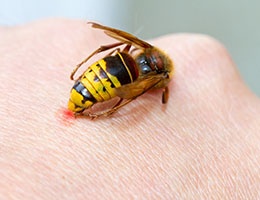 The majority of animal and insect bites and stings are harmless and can be managed at home. However, there are many that can cause a medical concern, some more acute than others. Read these 10 secrets to brush up on your approach to the patient who presents with a bite or sting this summer.
The majority of animal and insect bites and stings are harmless and can be managed at home. However, there are many that can cause a medical concern, some more acute than others. Read these 10 secrets to brush up on your approach to the patient who presents with a bite or sting this summer.
1) Most rabies cases in the U.S. are caused by bats.
Skunk, fox and raccoon bites can also transmit rabies to people. Groundhogs are the only rodents that transmit rabies. Chipmunks, mice, rats, rabbits and squirrels usually die before they can infect humans. The “rabid dogs” of yesteryear are very rare thanks to widespread canine vaccination in the U.S. Fortunately, only 2-3 people die from rabies in the U.S. each year.
2) Lyme disease is the most commonly reported tick-borne illness in the U.S.
96% of confirmed cases are from 14 states in the northeastern and upper midwestern U.S. The typical rash of erythema migrans is seen in 70%-80% of patients. About 10%-20% of patients treated for Lyme disease will have lingering symptoms known as “Post-Treatment Lyme Disease Syndrome.” In addition to Lyme disease and Rocky Mountain (RMSF) spotted fever, the CDC lists 13 more separate diseases transmitted by 9 different ticks.
3) Rocky Mountain spotted fever is found primarily in 5 states that are not in the Rocky Mountains.
North Carolina, Oklahoma, Arkansas, Tennessee and Missouri. RMSF can be a severe or fatal illness if not recognized and treated early. Typical symptoms include fever, headache, abdominal pain, vomiting and myalgia. A rash develops in 90% of patients, but often too late to be helpful in the diagnosis.
4) There are 7,000 to 8,000 poisonous snakebites yearly, resulting in 5 to 10 U.S. fatalities.
 First aid consists of supportive care, immobilization of the affected area, and transport to emergency care. Do not cut the bite wound, try to suck out the venom, or apply tourniquets or ice. Although half of bites by venomous snakes are “dry bites” with little or no injection of venom, immediate attention for all venomous snake bites is a must.
First aid consists of supportive care, immobilization of the affected area, and transport to emergency care. Do not cut the bite wound, try to suck out the venom, or apply tourniquets or ice. Although half of bites by venomous snakes are “dry bites” with little or no injection of venom, immediate attention for all venomous snake bites is a must.
5) Two spiders in the U.S. are venomous – the black widow and the brown recluse.
Spiders kill about 7 people per year. Black widow spiders have a “red hourglass” pattern on their abdomen, and their venom contains a neurotoxin that can cause painful spasms. Brown recluse spiders have a “violin” pattern on their upper back, and their bite releases an enzyme that causes local skin necrosis.
6) Scorpion stings are rarely life-threatening.
Stings usually occur in the southern and southwestern areas of the U.S.; they can be very painful. The most poisonous scorpion is the bark scorpion, found primarily in Arizona; there is now an antidote that can reduce the severity and duration of symptoms.
7) Bees, wasps and hornets kill more people in the U.S. every year than sharks, alligators, bears, snakes, spiders, ants and cows combined.
Bee, wasp and hornet stings cause about 58 deaths per year, usually by anaphylactic shock. Medical professionals need to be ready to treat these life-threatening anaphylactic reactions to bees, wasps and hornets. And yes, I mentioned cows, which kill about 20 people per year.
8) Jellyfish are the most common cause of stings in the ocean environment.
After removing any tentacles, treatment includes immersion of the affected arm or leg in hot water (104°F to 113°F; 40°C to 45°C) for 20 minutes. Salt water or saline is recommended, as fresh water can exacerbate the pain.
9) Dogs are responsible for 90% of animal bites
followed by cats (5%) and humans (2%-3%). Human bites often get infected. Cat bites become infected much more often (80%) than dog bites (5%). In the U.S., domestic dog bites rarely cause rabies. Worldwide, however, dogs continue as the major vector of rabies transmission due to inadequate vaccination programs.
10) Any time a child receives a bite from an adult, child abuse should be considered.
An adult bite injury on a child deserves special treatment. The child should be evaluated for possible child abuse, and the bite wound should be photographed and swabbed for forensic evidence. A forensic odontologist may need to be consulted.


